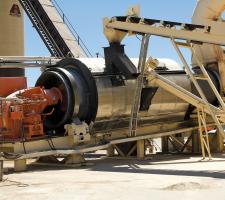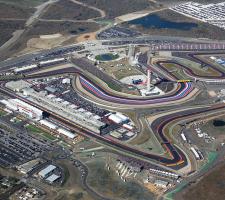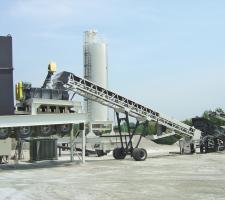
While one leading asphalt plant company has played a key role in the creation of the new Circuit of the Americas F1 racetrack, others have been releasing new plants and plant-related technology onto the market, some of which has been exhibited at major world industry shows. Guy Woodford reports
The asphalt base, binder, and surface courses for the 5.47km asphalt road course, which staged its first F1 race in November 2012, were all designed by
To prepare the site, approximately 2.48mn m³ (0.79tonnes) of earth were moved, and by the time the track was completed, approximately 535,188m³ of material were used to construct the racetrack.
General project contractor Austin Commercial’s excavation subcontractor, Ranger Excavation, moved the dirt and cut a 3.04m trench of Texas clay along the entire length of the track. As a separation layer, a black, 3cm, polyethylene liner was put down in the freshly excavated area. The crew then added 2.13m of sandy, clayey-loam select fill, 0.46m of pit-run clayey-sand, and 15.24cm of crushed, recycled concrete aggregate (RCA). The last prep layer placed by the crew consisted of 15.25cm of crushed limestone flex-base.
The track surface received three layers of pavement. The first layer placed by paving contractor
The new circuit required around 72,574tonnes of HMA, with around 9,525tonnes of surface mix on the wearing course alone. Austin Commercial placed a total of 19,050tonnes of critical wearing course, including the paved runoffs and verges. All the HMA was mixed using an Astec Double Barrel drum mixer.
“There are many differences between building a Formula 1 track and a high-level Interstate-type highway,” says Tom Byrum, management team member for Austin Commercial. “First, the surface mixture is a high-performance friction course with a high level of skid resistance, and the asphalt cement represents 6.5 per cent of the mix. At PG 82-22, the liquid asphalt was highly modified with SBS (styrene-butadiene-styrene) polymer. It could be considered a Superpave mix, very similar to stone-matrix asphalt, with high binder content and gap-graded aggregate, providing rock-on-rock contact with minimal fines. The track had to be durable and skid-resistant.”
Astec also showcased some of its latest plant technology as part of the Astec Industries stand at
Its offering included a one-eighth scale model of a complete Astec M-Pack relocatable asphalt facility. Since its debut at
“The innovative M-Pack facility features the Astec exclusive Double Barrel technology and new generation long-term storage silos,” says Astec.
“Created for producers who don’t move often but want to reap the benefits of fast plant setup when they do, the M-Pack is designed with self-contained, skid-mounted modules for maximum efficiency and cost savings. Another added benefit is the minimal site preparation costs that are required to accommodate an Astec M-Pack Double Barrel plant.”
Also on display at the Munich, Germany-based event, the largest construction equipment show in the world, was a full-size Astec Double Barrel drum dryer/mixer. The Double Barrel dryer/drum mixer combines the functions of a dryer and a continuous-process mixer in one compact, efficient system. Drying of the virgin aggregate is the first step in the process and takes place inside the inner drum. Mixing of aggregate and other ingredients follows, which happens in the outer chamber of the stationary shell. Each drying and mixing step will be highlighted on this drum.
“Equally important to the state-of-the-art technology and high quality that every Astec plant offers, is their commitment to after-sales service, technical support and parts support. Service personnel are dispatched globally to support the set up and commissioning of plants as well as to train plant operators,” says the company.
With the design of its new mobile drum mix asphalt model, the CDM-70/80, Çesan says it has managed to create a valuable addition to its product line. Having already sold one to Cyprus and one to Cameroon, Çesan is aiming to increase its stronghold in the North African territories with its new model.
Having the ability to transport a 60-80 tonnes/hour drum mix asphalt plant with one chassis over great distances has been a crucial consideration for constructors in areas with limited infrastructure and bad road connections. Çesan says the single chassis CDM-70/80 covers the filter, aggregate silos mixer and control cabin all-in-one.
“Our aim was to enter this niche market, where constructors prefer to buy small capacity plants to perform road work and projects which are not accessible via large capacity plants,” said Tahir Aydogdu, the Turkish firm’s general manager.
“We have listened to the request of our customers and designed a plant that will fit the small-medium size companies which have vast amount of projects spread around a country where mobility is very difficult for them,” added Aydogdu, who said Çesan were “finalising deals” with two other North African clients interested in buying the CDM-70/80.
Çesan has also created the King Batch - a new design asphalt plant. The new plant, with a 280tonnes/hour capacity, was shipped to bauma 2013 with only eight trucks. The King Batch’s transport and erection time is said to be drastically reduced due to its compact design.
With the CDM-70/80 and King Batch, Çesan is aiming to increase their sales numbers this year especially in the African, Middle East and CIS areas. The firm says its latest plant models are the result of listening to the needs and requests of its customers, who have stressed that compact and easily transportable plants cut vital costs.
Asphalt Drum Mixers (ADM) is now offering its new Excalibur counter-flow drum mixer. The EX-SS model can provide a throughput of 72.5-109tonnes/hour and ADM president Mike Devine said, “This is the first side by side we’ve built.”
Durability, reliability and versatility are all claimed for the Excalibur series plants, which are mounted on heavy-duty chassis with tractor trailer hitches and can be towed to site and commissioned quickly. Adjustable, crank-down support legs with sand shoes make the equipment quick to erect and also take down to move to another site, increasing versatility and transportability. Weighing in at 52tonnes and measuring 20.7m long, the EX-22 is 4.39m wide and 4.3m high.
A wide array of options is available and the unit is controlled by a relay logic-based operator control console, with an ADP-020 process controller. This sophisticated controller automatically meters asphalt and aggregate flow rates to set mix design formulae and the system is programmable, with features including automatic moisture detection and liquid asphalt weight temperature compensation. The control room is of all-welded, all-steel frame construction that includes wall studs, ceiling rafters and floor joists.
The company is also notching up sales both in the US and overseas, with equipment being exported to Algeria, Nigeria and Russia. Devine said, “We’ve got more work to date than we had all last year.”
ADM says it now also offers portable and stationary weigh conveyors compatible with its own and similar competitive asphalt plant models. Weigh conveyors transfer material from cold feed bins into the drum and are designed to give an accurate weight measurement of the aggregate, allowing operators to achieve an optimum asphalt mix. Five models are available with various dimensions to meet the demands of many operations.
The US family-owned firm’s weigh conveyors are available in truss or C-channel frame configurations. The drive system features a 1,800-rpm high efficiency motor, head-shaft-mounted gearbox, V-belt drives and high performance pulleys and idlers. Open-mesh safeguards protect the belt drives, and a sensor on the tensioning idler monitors the speed. The conveyor also includes an adjustable self-cleaning winged tail idler assembly, and the head section contains a spring-tensioned polyurethane belt scraper.
A concentric cam vibrates the unit’s scalper screen, which has 1.5-inch square openings to ensure that oversized material does not enter the drum. Material that is too large to pass is directed to the divert/reject chute. A double-deck scalper screen with pneumatic deck selection is an available option.
The conveyor’s weighbridge features an NTEP-approved high capacity load cell and is engineered to provide precise measurements. A shroud eliminates wind interference, while the gravity take-up system keeps the multi-ply belt in contact with the weighbridge at all times.
Portable units are transported on a single-axle trailer with a pintle ring hitch for easy towing. The smallest model uses electric brakes, and all other models feature air brakes.
State-of-the-art CFD simulation is said by the Swiss company to be behind the increase in flow distribution quality. As a result, filter bags are said to be filled more evenly, which improves their efficiency and useful life.
Key to high separation accuracy of the fine and coarse filler is what is described as a new and innovative pre-screener. The heightened degree of separation also, in turn, improves the quality of reclaimed filler.
The new heat package for the AFA 3018 is said to ensure that the temperature loss in the filter never exceeds 10°C due to the presence of pre-heated cleaning air. The claimed ‘intelligent’ heating process is said to remove adherent filler gently and thoroughly from the Ammatex filter bags. Ammann says the Ammatex filter bags are high temperature resistant and do not require a fresh air flap.
Meanwhile, the Rotor-Step cleaning system for the AFA 3018 is said to be robust, easy to maintain and highly durable thanks to reliance on a small number of moving parts. The optimised flushing method is also said by Ammann to save energy as it works without the need for an additional fan or compressed air.
Ammann says all the AFA3018 filter’s replacement parts and maintenance points are easily accessible.
Designed to allow hot and cold recycling and with a capacity of 120tonnes/hour, the new CSD 1500 enables the integration of a hot storage silo with a 50tonne capacity. Similar to all Lintec’s CSD line plants, the aggregates enter the screen drum through the front wall.
Delivering a 1.5tonne sized batch, the hot storage silo comprises two 25tonne chambers. The new plant’s horizontal skip bucket is 2tonnes with emergency discharge of 3.5tonnes. Bitumen tanks with the plant can either be containerised (vertical) or conventional (horizontal), with an agitator for (Polymer Modified Bitumen} PMB available for both.
The CSD 1500 can be heated electrically or with thermal oil.
The eTOWER plants can use all modern recycling systems. There are two systems for introducing RAP: a recycling ring and direct introduction in the mixer via a specific elevator. In combination, recycling rates of 50% are said to be achievable. For even higher recycling rates, the eTOWER plants can be equipped with an additional parallel dryer drum for RAP.
Part of the eTOWER plant range designed for output of up to 180tonnes/hour, the eTOWER 2500 comes with the AQUABlack foam bitumen production system, so the final asphalt temperature can be reduced by more than 30°C due to its patented Foaming Gun.
For simple transport the eTOWER plants are just 2.5m wide, allowing them to be moved on European roads as standard loads.
Benninghoven’s recycling innovation
Speaking at bauma 2013
“In order to save valuable resources we have developed a special machine that can handle big lumps of recycling material which then separates it back into its own original structure,” he explained. “This then allows you to add as much recycling as possible which is important. It is basically not a crushing effect, it is a separation effect. This is achieved by a two-line crusher system or granulator.”
The system, said Benninghoven, allows you to include an extremely high content of recycled material in an asphalt plant mix as the recycled material is of a superior quality.
“We listened to the demands of customers and have made some developments on it, especially the capacity and separation. The first trials have been very positive,” added Benninghoven.
E-Mak’s new asphalt plant
Turkish asphalt plant specialist
The machine uses heat generated by the burner and flows this hot air through the tower. The RAP elevator carries the material to a bin with a special valve underneath that then controls the feed quantity. Specially designed flights inside the tower increase the time that the material takes to descend so as to increase heat absorption. This provides additional mixing with the internal layout also minimising the risk of material sticking. As it passes through the tower the RAP is heated to 120°C and is then mixed with the fresh aggregate, which is heated to 180°C and fed through the dryer drum.
The machine can produce 80tonnes/hour of high quality asphalt and with a feed input of 35-40% RAP. The company has high hopes for this unit and believes it will allow efficient production of high quality asphalt using recycled materials.
RSS














